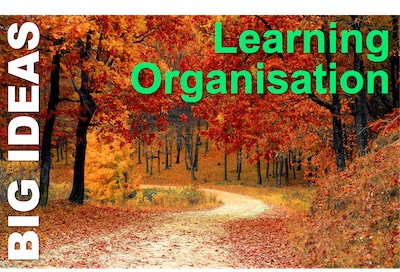
 What’s the biggest long-term competitive advantage an organisation can have? It’s the ability to adapt rapidly to changing circumstances. And for that, it needs to learn. That’s the Big Idea behind Peter Senge’s Learning Organisation.
What’s the biggest long-term competitive advantage an organisation can have? It’s the ability to adapt rapidly to changing circumstances. And for that, it needs to learn. That’s the Big Idea behind Peter Senge’s Learning Organisation.
The Learning Organisation sits at the confluence between two powerful forces for good:
- Individual learning, development, and personal growth
- Systems thinking that allows us to mentally connect up the network of parts into a complex whole
What it means is simple in concept, though fiendishly hard to achieve in practice. A learning organisation is one that continually develops and evolves so that everyone shares a consistent vision and collectively prepares themselves to meet the next challenge in achieving it.
Why Do We Need Learning Organisations?
If I suggest that we need learning organisations to adapt to the constant changes that they face, I’m in danger of entering cliché-land. But it is true.
The problem is that, for each individual in the organisation, the immediate pressure is to do more of the same. To focus on their local priorities and compete with colleagues to gain a bigger share of the corporate pie. It is far easier to focus on current events than to sit up and look to the horizon. So, while we do that, the world changes around us. And one day, we notice that everything is different and we don’t have the answer, the capabilities, nor the connections to succeed.
When that happens everywhere across a whole organisation, that organisation is in a downward spiral.
In the Learning Organisation, we make time to survey the landscape. We discuss what it means for everyone, and what systematic changes and developments will fit us best for making those changes.
The Benefits of a Learning Organisation
Do I need to say much more beyond the word ‘survival’? Because the ability to adapt is clearly a competitive advantage. Indeed, the Journal of Business Strategy named the originator of the Learning Organisation, Peter Senge, as their ‘Strategist of the Century’ for this reason. If you don’t adapt, others will. Then they will out-compete you and you will die.
Examples of how learning organisations can gain competitive advantage include:
- Product innovation
- Meeting emerging customer needs
- Cost reduction
- Marketing excellence
- Diversification or divestment
- Improved culture and sense of community
What is A Learning Organisation?
The best way to describe a Learning Organisation is in terms of the five disciplines it pursues.
The idea of the Learning Organisation originates with Peter Senge (pronounced Sen-jee). He documented it in his series of books starting with the seminal 1990 book, ‘The Fifth Discipline’. A Learning Organisation is one that masters and practises the five disciplines.
The Five Disciplines
Those five disciplines are:
- Personal Mastery
At the heart of the Learning Organisation are individuals who treat constant personal development as a discipline that will take them in the direction of mastery in whatever they focus on. But they know they will never reach it. - Mental Models
These are the sets of assumptions, generalizations, or internal images of how the world around us works. They are what we use to translate events into interpretations. And our decisions and judgement are only as good as the qualities of our observation and our mental models. - Building Shared Vision
By this, Senge means the larger organisational purpose that binds people together and fosters a genuine commitment to work together. In a Learning Organisation with a truly shared vision, people commit because they want to. In others, they may act solely because of a compulsion to comply. - Team Learning
By working together, a team can tackle complex problems and bring multiple angles of insight to bear. But to do this well, they need a deep dialogue, the ability to put aside assumptions, and the trust to learn from one another. - Systems Thinking
Systems Thinking is the ‘Fifth Discipline’ that binds together the other four. It is the exact opposite of breaking a complex organisation into its constituent parts, to better understand it. Rather, systems thinking examines the organisation as a whole, and studies the interdependencies and connections among its components. ‘All things are connected’ is the principle of systems thinking. So any decision you make in this place and at this time can have subtle or even profound effects in other places and into the future.
How to Build a Learning Organisation
You cannot just make your organisation into a learning organisation. It takes time, investment, and leadership.
You’ll need to work, with your colleagues, on:
- Purpose, vision, values
- Policies and processes that favour systems thinking
- Education – both technical and cultural
- Knowledge sharing – and diffusion throughout the organisation
- Enrolling people into the mission
- Role-modeling decisions and actions system-wide, rather than locally
- Encouraging challenge and experimentation to refine or even overthrow outdated mental models
- Supporting infrastructure to make all of this as easy as possible
The challenge is that all of this is very difficult. And the fact of it is that very few organisations have been able to make it work. It flies in the face of prevailing cultural, political, and social mores.
There can be no doubt that a Learning Organisation is an ideal to which we should aspire. But the path to achieving it is little-trodden, and templates for how to do it are a rarity.
What is Your experience of Learning Organisations?
We’d love to hear your experiences, ideas, and questions. Please leave them in the comments below.
